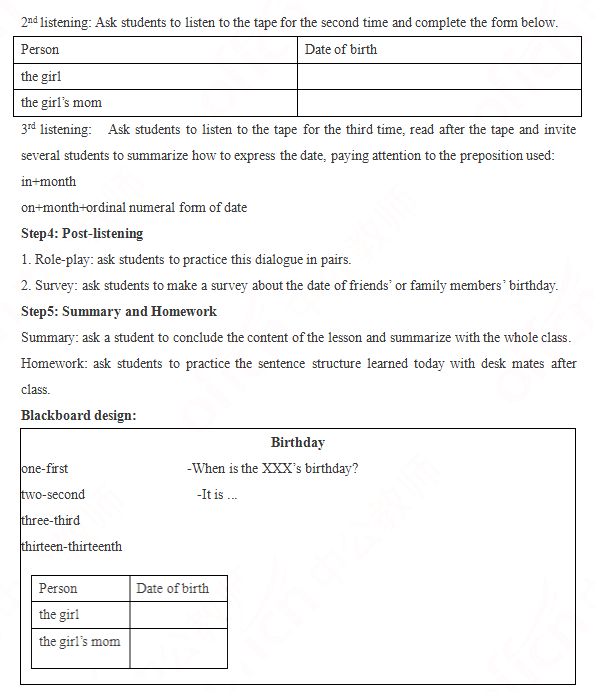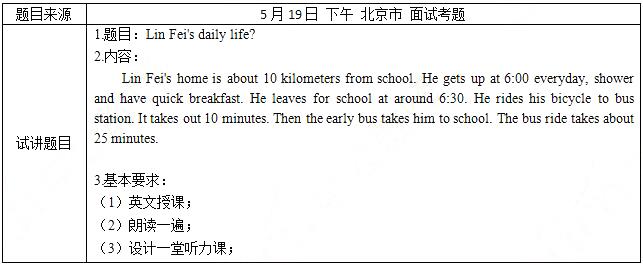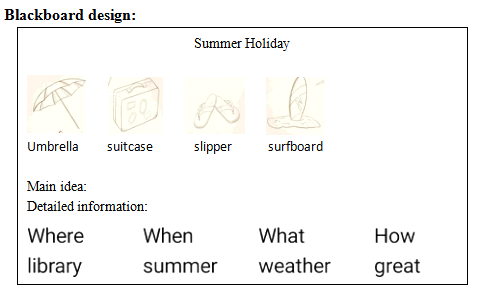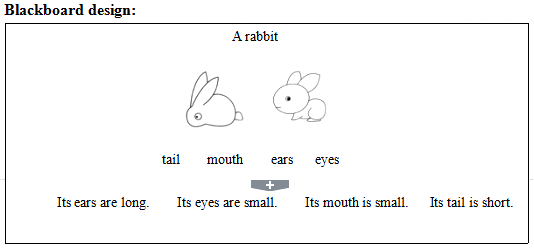Teaching activities must be based on the students' cognitive development level and theexistingexperiencedknowledge,thus,students'personal knowledge,students' Lifeworld and__________ are also the important curriculum resources except textbook. A.game activ
题目
Lifeworld and__________ are also the important curriculum resources except textbook.
B.labour activities
C.attitudes
D.direct experience
相似考题
更多“Teaching activities must be based on the students' cognitive development level and theexistingexperiencedknowledge,thus,students'personal knowledge,students' ”相关问题
-
第1题:
Teaching activities must be based on the students' cognitive development level and the existing experienced knowledge, thus, students' personal knowledge, students' life world and are also the important curriculum resources except textbook.A.game activities
B.labour activities
C.attitude
D.direct experience答案:D解析:考查教学活动。教学活动必须建立在学生的认知发展水平和已有的知识经验基础之上。因此.学生的个人知识储备、生活世界和直接经验都是重要的课程资源。所以D项正确。 -
第2题:
During class,the teacher leads students to memorize the important points of the teaching content.On one hand,the teacher helps students to grasp the key points.On the other hand,what learning strategy is the teacher teaching?A.Cognitive strategy.
B.Self-management strategy.
C.Communication strategy.
D.Resource strategy.答案:A解析:本题考查新课标相关的英语学习策略
A选项,认知策略,老师在教学中引导学生对教学要点进行记忆,一方面是为了让学生了解课程内容的重点,另一方面是为了传授学生学习策略,而在学习中记住要点是属于学习策略中的认知策略。综上,A选项正确。
B选项,自我管理策略,故排除。
C选项,交际策略 ,故排除。
D选项,资源策略 ,故排除。
故正确答案为A 项。 -
第3题:
Teaching activities must be based on the students' cognitive development level and the existing experienced knowledge, thus, students' personal knowledge, students' life world and__________ are also the important curriculum resources except textbook.A.game activities
B.labour activities
C.attitude
D.direct experience答案:D解析:考查教学活动。教学活动必须建立在学生的认知发展水平和已有的知识经验基础之上。因此,学生的个人知识储备、生活世界和直接经验都是重要的课程资源。所以D项正确。 -
第4题:

二、考题解析
【教案】
Teaching aims:
Knowledge aim:
Students will master the expression of date and the sentence structure: -What is ...’s birthday? -It is ...
Ability aim:
Students will improve their abilities of speaking and listening.
Emotional aim:
Students will be more confident in speaking English.
Key and difficult point:
Key Point: Students will master how to express a date in English.
Difficult Point: Students will use the sentence structure in daily life.
Teaching procedure:
Step 1: Warming-up
1. Greetings.
2. Ask students if today is anyone’s birthday. And invite the whole class to sing a ‘Happy Birthday’ song to him or her.
Step 2: Pre-listening
1. Review the knowledge about ordinal numeral: write some numbers on the blackboard and ask students to change the cardinal numeral into ordinal numeral.
2. Ask students to look at the picture in the textbook to predict what the dialogue may be about.
Step 3: While-listening
1st listening: Ask students to listen to the tape for the first time and check if their prediction is correct or not.

答案:解析:暂无解析 -
第5题:

二、考题解析
【教案】
Teaching Aims:
Knowledge aim: Students will master the words and expressions to describe their favourite club and explain their personal taste for club.
Ability aim: Students can express their favourite things and communicate with others around the given topic.
Emotional aim: Students will express themselves and show their personalities to the others with confidence.
Teaching Key Points:
Students can express their personal choices for clubs in English.
Teaching Difficult Points:
Students can express themselves correctly and fluently and gain the confidence of speaking English.
Teaching Methods:
Communicative teaching method, task-based teaching method and audiolingual teaching method.
Teaching Aids:
Video, Blackboard and so on.
Teaching Procedures:
Step 1: Warming-up
1.Greeting with with the students and show them a picture on the screen. The content of the picture is a entry test question of high-IQ club Mensa, which is very hard.
2.Show students a video about Mensa club -- a high-IQ club in the world to lead to the main topic of this lesson -- clubs.
Step 2: Pre-speaking
1. Do a brainstorming about “various kinds of club they know” by asking the question “ Is there any club you know?”
2. Record the answer on the blackboard.
3.Introduce some new type of club like Home club,ACG-lover club and Fit club to the students.
Step 3: While-speaking
Divide students into groups of four and ask them to do a survey about “ Which club do you like?” and make a chart according to the discussion result.
During the survey, try to briefly explain the reason why they like this club. Give them ten minutes.
 答案:解析:暂无解析
答案:解析:暂无解析 -
第6题:
初中英语《Lin Fei's daily life?》
一、考题回顾

二、考题解析
【教案】
Teaching Aims:
Knowledge aim: Students will be able to describe their daily life and acquire some knowledge about listening strategies.题目来源于考生回忆
Ability aim: Students can obtain the main idea quickly from the listening material and develop the ability of grasping detail information.
Emotional aim: Students can foster the interest and desire of learning English, and be fond of taking part in kinds of practical activities.
Teaching Key Points:
Students can get the main idea and useful information from the listening material.
Teaching Difficult Points:
Students can apply these skills in their listening and apply these expression in their daily communication.
Teaching Methods:
Communicative teaching method, task-based teaching method, audio-lingual teaching method.
Teaching Aids:题目来源于考生回忆
PPT, Blackboard, recorder and so on
Teaching Procedures:
Step 1: Warming up
1.Greetings
2.Sing an English song It' my life, invite the whole students to clap when singing together and lead to the topic.
Step 2: Pre-listening
1.Free talk: Give students three minutes to talk about their own daily life and invite them to share it.
2.Prediction: Let students work in pairs and ask them to predict Lin Fei's daily life.
Step 3: While-listening
1. Listen to the tape for the first time and ask them when Lin Fei gets up and when he goes to school, then let students to share answers.题目来源于考生回忆
2.Listen to the tape for the second time and ask them to fill in the chart, then invite them to share their answers.
Step 4: Production
1.Retelling: Ask students to retell Lin Fei's daily life with the help of the chat in their own words, and teacher will give them 3 minutes to prepare it and 3 minutes later, invite some students to share their retelling in the front.
2.Survey: Let students discuss their own daily life in the group of four and make a report in the form of chart. 8 minutes later teacher invites some groups to share the result of their reports.
Step 5: Summary & Homework
Summary : Invite a little teacher to help teacher make a summary of this class.
Homework: Let students introduce their daily life to their parents and make a share in the next class.
Blackboard design:
 答案:解析:暂无解析
答案:解析:暂无解析 -
第7题:

二、考题解析
【教案】
Teaching Aims:
Knowledge aim: Students will be able to describe their summer holiday and acquire some knowledge about listening strategies.
Ability aim: Students can obtain the main idea quickly from the listening material and develop the ability of grasping detail information.
Emotional aim: Students can foster their interest and desire of learning English, and be fond of taking part in kinds of practical activities.
Teaching Key Points:
Students can get the main idea and useful information from the listening material.
Teaching Difficult Points:
Students can apply these skills in their listening and apply these expression in their daily communication.
Teaching Methods:
Communicative teaching method, task-based teaching method, audio-lingual teaching method.
Teaching Aids:
PPT, Blackboard, recorder and so on
Teaching Procedures:
Step 1: Warming up
1.Greetings
2.Sing an English song Summer Holiday, invite the whole students to clap when singing together and lead to the topic.
Step 2: Pre-listening
1.Brainstorm: Give students 3 minutes to say something about summer holiday as much as they can.
2.Clean up obstacle:Use pictures to teach students some difficult words or explain some words by English explanation.
Step 3: While-listening
1. Listen to the tape for the first time and ask them what the passage is mainly about, then let students share their ideas.
2.Listen to the tape for the second time and ask them to fill in the chart, then invite them to share their answers.
Step 4: Post-listening
1.Discussion: Ask students to discuss what they will do this summer holiday with their partners, and teacher will give them 3 minutes to prepare it and 3 minutes later, invite some students to share their own summer holiday in the front.
2.Report: Let students to write down plans of their own summer holiday with the key words and key sentences that they have learned today, 8 minutes later teacher invites some students to share the result of their reports.
Step 5: Summary & Homework
Summary : Invite a little teacher to help teacher make a summary of this class.
Homework: Let students prefect their plans of summer holiday and share with their parents.
 答案:解析:暂无解析
答案:解析:暂无解析 -
第8题:

二、考题解析
【教案】
Teaching Aims:
Knowledge aims:
(1) Students will master two difficult words,such as universal, unfamiliar.
(2) Students will learn knowledge about body language.
Ability aim: Students are able to understand the meaning of body language in their daily life and can improve the ability in scanning and skimming.
Emotional aim: Students can show their feelings with body language in reality.
Teaching Key Points:
Students can know the meaning of various body languages.
Teaching Difficult Points:
Students are able to express their feelings with body language in reality..
Teaching Methods:
Communicative teaching method, task-based teaching method, situational teaching method.
Teaching Aids:
PPT, Blackboard and so on
Teaching Procedures:
Step 1: Warming up
1.Greetings
2.Play a clip from a popular American TV series Lie to me (many body languages are shown in it), invite two students to talk about their feelings.
Step 2: Pre-reading
1.Let’s say. Lead students to talk about body languages that we usually see in our daily life.
Step 3: While-reading
1.Fast reading. Read the passage for the first time and ask students to summarize the main idea.
2.Careful reading. Read the passage for the second time with questions.
(1) How many body languages are mentioned in the passage when we meet others?
(2) what is the difference in different countries? Talk it in details.
Step 4: Post-reading
Divide all students into several groups and give them five minutes to discuss other body languages that we usually use. After that, invite three students to share.
Step 5: Summary & Homework
Summary : students look at the blackboard and summarize this class.
Homework:students surf the internet and collect more information about body language..
Blackboard design:
 答案:解析:暂无解析
答案:解析:暂无解析 -
第9题:
Which of the following is true of formative assessment ( )
A. Mainly based on testing.
B. Done mostly at the end of a learning period.
C. Mainly for testing students’ knowledge and skill.
D. Focused on the progress of students.答案:D解析:形成性评价强调的是学生学习的过程,而不是结果。 -
第10题:
单选题When teaching students how to give appropriate responses to a congratulation or an apology,the teacher is probably teaching at ______ .Alexical level
Bsentence level
Cgrammatical level
Ddiscourse level
正确答案: A解析: -
第11题:
单选题What purpose do post-listening activities NOT serve?AHelping students relate the text with their personal experience.
BOffering students the opportunities of extending other language skills.
CPracticing students' ability of matching the pre-listing predictions with contents of the text.
DEnabling students to have a discussion about the topic.
正确答案: B解析: -
第12题:
单选题What purpose does NOT post-listening activities serve? _____AHelping students relate the text with their personal experiences.
BOffering students the opportunities of extending other language skills.
CPracticing students’ ability of matching the pre-listing predictions with contents of the text.
DGiving the answer directly to students and not to explain.
正确答案: C解析:
C项matching the pre-listing predictions with contents of the text不是听力活动的内容,也不是听力活动的目的。 -
第13题:
During class, the teacher leads students to memorize the important points of the teaching content. On one hand, the teacher helps students to grasp the key points. On the other hand, what learning strategy is the teacher teaching?A.Cognitive strategy
B.Self-management strategy
C.Communication strategy
D.Resource strategy答案:A解析:本题考查英语学习策略
A选项,老师在教学中引导学生对教学要点进行记忆,一方面是为了让学生了解课程内容的重点,另一方面是为了传授学生学习策略,而在学习中记住要点是属于学习策略中的认知策略。综上,A选项正确。
B选项,自我管理策略,故排除。
C选项,交际策略 ,故排除。
D选项,资源策略 ,故排除。
故正确答案为A 项。 -
第14题:
Which of the folIowing statements about take-based language teaching is NOT true?A.Students should be given tasks to perform or problems to solve in the classroom.
B.Students are task-driven.
C.Task-based language teaching is student-centered.
D.Task-based language teaching is teacher-centered.答案:D解析:考查任务型语言教学。任务型语言教学以学生为主体,以任务为中心,学生通过参与和完成一系列的任务来习得语言知识。任务型教学法的基本学习步骤分为前任务(pre.task)、任务环(task cvcle)和语言聚焦(1anguage focus)三个部分。故选D。 -
第15题:
Teaching students of threshold level is hard work but the effort is very worthwhile.A:precious
B:rewarding
C:worth
D:challenging答案:B解析:教入门级的学生需要付出大量努力,但结果很另人欣慰。precious“珍贵的”,例如:Pandas are precious creatures.熊猫是珍贵的动物。rewarding“值得的、有回报的”, 最符合题意,例如:To spend some time in English is rewarding.花点时间学英语是值得的。 worth“值得的”,多用be worth doing/sth.例如:The house is worth a lot of money.这栋房子值很多钱。challenging“有挑战的”,例如:I intend to give up my present post in order to get a more challenging opportunity.为了获得一个更有挑战性的工作机会,本人打算放弃目前的职位。 -
第16题:

二、考题解析
【教案】
Teaching Aims:
Knowledge aim: Students will be able to describe their daily life and acquire some knowledge about listening strategies.题目来源于考生回忆
Ability aim: Students can obtain the main idea quickly from the listening material and develop the ability of grasping detail information.
Emotional aim: Students can foster the interest and desire of learning English, and be fond of taking part in kinds of practical activities.
Teaching Key Points:
Students can get the main idea and useful information from the listening material.
Teaching Difficult Points:
Students can apply these skills in their listening and apply these expression in their daily communication.
Teaching Methods:
Communicative teaching method, task-based teaching method, audio-lingual teaching method.
Teaching Aids:题目来源于考生回忆
PPT, Blackboard, recorder and so on
Teaching Procedures:
Step 1: Warming up
1.Greetings
2.Sing an English song It' my life, invite the whole students to clap when singing together and lead to the topic.
Step 2: Pre-listening
1.Free talk: Give students three minutes to talk about their own daily life and invite them to share it.
2.Prediction: Let students work in pairs and ask them to predict Lin Fei's daily life.
Step 3: While-listening
1. Listen to the tape for the first time and ask them when Lin Fei gets up and when he goes to school, then let students to share answers.题目来源于考生回忆
2.Listen to the tape for the second time and ask them to fill in the chart, then invite them to share their answers.
Step 4: Production
1.Retelling: Ask students to retell Lin Fei's daily life with the help of the chat in their own words, and teacher will give them 3 minutes to prepare it and 3 minutes later, invite some students to share their retelling in the front.
2.Survey: Let students discuss their own daily life in the group of four and make a report in the form of chart. 8 minutes later teacher invites some groups to share the result of their reports.
Step 5: Summary & Homework
Summary : Invite a little teacher to help teacher make a summary of this class.
Homework: Let students introduce their daily life to their parents and make a share in the next class.
Blackboard design:
 答案:解析:暂无解析
答案:解析:暂无解析 -
第17题:
初中英语?阅读
一、考题回顾

二、考题解析
【教案】
Teaching aims:
Knowledge aim:
Students will grasp and understand the main and detailed information of the passage.
Ability aim:
Students will improve their reading and speaking skills.
Emotional aim:
Students will foster the interest and desire of learning English and take part in speaking activities actively.
Key and difficult point:
Key Point: Students will totally understand the content of the passage.
Difficult Point: Students will foster the interest of learning English, and take part in speaking activities.
Teaching procedure:
Step 1: Warming-up
1. Greetings.
2. Show students pictures about different types of transportation and naturally lead to today’s topic.
Step 2: Pre-reading
1. Ask students two questions and some volunteers will be invited to share their answers.
Q1: How do you come to school?
Q2: How do your parents go to work?
2. Ask students to predict the main idea of the passage based on the above discussion and pictures on the screen.
Step 3: While-reading
1st reading: Ask students to read the passage for the first time and check their prediction. Besides, they need to find out which countries are mentioned in the passage and circle them.
2nd reading: Ask students to read the passage for the second time and complete the following chart. Some students will be invited to finish it on the blackboard.

Step4: Post-reading
Discussion: ask students to discuss the advantages and disadvantages of different modes of transportation. Four students in a group, after five minutes, some groups are supposed to show their results.
Step5: Summary and Homework
Summary: ask a student to conclude the content of the lesson and summarize with the whole class.
Homework: ask students to investigate their friends’ way of going to school and find some interesting ways of transportation on the Internet.
Blackboard design:

1. How to improve students’ reading and speaking ability in your class?
2. How did you evaluate the performance of students in the class?答案:解析:1.
It is very important to improve students’ reading and speaking abilities. In my class, I take three specific steps to improve their reading and speaking abilities. Firstly, before reading the article, I ask the students to guess the main idea of the article according to my questions and pictures on the screen. As you heard, this can not only exercise students’ guessing ability, but also help them read the passage with questions. In the while-reading part, I set two times of reading, namely extensive reading and intensive reading. Obviously, students’ scanning ability and the ability to grasp detailed information can be improved. It also helps them form good reading habits. As for speaking ability, I organize a discussion activity without standard answers. Students can express their views freely in groups. In this way, their reading and speaking abilities can be improved a lot.
2.
Students are under a stage of growing and developing. They are eager to be evaluated and encouraged by their teachers. At the same time, students are different, and their acceptance and abilities of learning are different. Therefore, in my class, I have adopted a variety of different evaluations. For the students who answered correctly, I would praise them directly, such as “excellent”, “you can find the answer so fast”. For those students who dare not answer questions or did not find out the answers, I just encouraged them and guided them to say the answers, and gave some encouraging comments, like “nice try!”, “you’ve made a great progress”. Also, some students made mistakes. In my class, instead of directly blaming the student for being wrong, I asked other students to help him/her and give them a proper evaluation. -
第18题:

二、考题解析
【教案】
Teaching Aims:
Knowledge aim: Students will master the content about hobbies.
Ability aim: Students can improve their writing ability about hobbies, such as drawing.
Emotional aim: Students will foster a hobby and know how to keep it.
Teaching Key Points:
Students know the content about hobbies and can improve their writing ability about hobbies.
Teaching Difficult Points:
Students can learn how to write, basing on their hobbies..
Teaching Methods:
Communicative teaching method, task-based teaching method, situational teaching method.
Teaching Aids:
PPT, Blackboard and so on
Teaching Procedures:
Step 1: Warming up
1.Greetings
2. Show two pictures about hobbies , ask all students to observe and describe.
Step 2: Pre-writing
1. Divide students into two groups, group A and group B and ask them to read the the dialogue.
2. Lead students to summary the main idea.
3.Read the dialogue by themselves again, then ask them some questions to get details.
(1) What are they fond of?
(2) How about drawing, what can it teach you?
(3) Where will they go?
4. Ask students to work in groups and discuss, do a survey on hobbies and reason, collecting key points.
Step 3: While-writing
Students write an article within 20 minutes.
Step 4: Post-writing
1.Self editing: students work in pairs to check if there are faults in spelling and grammar.
2.Sharing: choose 1-2 writing and show it on the screen.
3.Evaluating: appreciate and give comments.
Step 5: Summary & Homework
Summary : students look at the blackboard and summarize this class.
Homework:students talk about their hobbies to their friends or parents.
Blackboard design:
 答案:解析:暂无解析
答案:解析:暂无解析 -
第19题:

二、考题解析
【教案】
Teaching Aims:
Knowledge aim: Students will master the sentence structure “We have great bags for only ¥12! we have....for only....; You can buy...for only .... ”.
Ability aim: Students can use these sentence structures to apply in their daily life.
Emotional aim: Students will improve their confidence of learning English and not afraid of speaking English in Class.
Teaching Key Points:
Students know the expressions about describing great sale and master the sentence structure.
Teaching Difficult Points:
Students can apply the expressions into daily communication.
Teaching Methods:
Communicative teaching method, task-based teaching method, situational teaching method.
Teaching Aids:
PPT, Blackboard and so on
Teaching Procedures:
Step 1: Warming up
1.Greetings
2.Play a video about an advertisement of Huawei phone and invite students to talk about the content of this video.Then the teacher leads in the topic of “Huaxing’s great sale.”
Step 2: Pre-speaking
1.Show two pictures about Huaxing store and its great sale advertisement.
2.Let students listen to the tape and find out what things are at great sale.
3.Ask students to listen to the tape again and collect the useful expressions about great sale.
Step 3:While-speaking
1. Ask students to read Huaxing’s store’s advertisement actively and vividly.
2. Let students talk about the expressions of great sale.
3. Role-play: students work in pairs to make conversation.Suppose there is a situation that you own a store. One student is shop assistant, the other students is customer. Teacher will give them 8 minutes to prepare it.
Step 4: Post-speaking
Share and evaluation: Invite some students to perform the conversation in the front.
Step 5: Summary & Homework
Summary: let them look at the blackboard and summarize this class.
Homework: Ask students to design a poster of their own store’s great sale and share it next class.
Blackboard design:
 答案:解析:暂无解析
答案:解析:暂无解析 -
第20题:

二、考题解析
【教案】
Teaching Aims:
Knowledge aim: Students will master the words “long, small,short, ears, eyes mouth,tail...”
Ability aim: Students can get the key information about rabbit and use the words to describe other animals.
Emotional aim: Students will improve their interest in English.
Teaching Key Points:
Students can understand the meaning of the words“long, small short” and use them to describe other animals.
Teaching Difficult Points:
Cultivate students awareness of loving animals and protecting animals.
Teaching Methods:
TPR teaching method, Communicative teaching method, task-based teaching method.
Teaching Aids:
Pictures, Blackboard and so on.
Teaching Procedures:
Step 1: Warming up
1.Greetings
2.Let students guess a riddle about rabbits. (Teacher need to make some actions to help students guess the answer- rabbit) and then lead in the topic “A rabbit”.
Step 2: Pre-reading
1. Show Students different pictures of rabbits to let students discover the common points.
2. Invite two students to try to describe rabbits in their own words.
3. Teach students these words “ tail, mouth ,ears,eyes”
Step 3: While-reading
1.Let students read the sentences and circle the words that are used to describe rabbits and invite one student to share.
2.Read them again and find out what part of the rabbits do they describe? After that,invite two students to write and draw a picture on the blackboard.
Step 4: Post-reading
Make a survey: Let students work in group of four. They’ll be given 15 minutes to ask each other about what are they favorite animals and fill in the survey table. After that, invite some students to share their survey result by intimating the animals in front of the blackboard.
Step 5: Summary & Homework
Summary: Invite a student to be a small teacher, to make a summary about what we have learned today.
Homework: Draw a picture of your favorite animals and share it to your friends.
 答案:解析:暂无解析
答案:解析:暂无解析 -
第21题:
Which of the following is true of formative assessment ( )
A、 Mainly based on testing.
B、 Done mostly at the end of a learning perio
D、
C、 Mainly for testing students’ knowledge and skill.
D、 Focused on the progress of students.答案:D解析:形成性评价强调的是学生学习的过程,而不是结果。 -
第22题:
单选题What’s the overall goal of English teaching in basic education stage? _____AIncrease students’ vocabulary and grammar of the knowledge.
BImprove the students’ English learning and foreign cultural interesting.
CCultivate the students’ ability of listening and spoken English.
DCultivate students’ comprehensive capability of language.
正确答案: C解析:
基础教育阶段英语教学的总体目标是培养学生的综合语言运用能力。 -
第23题:
单选题Teaching activities must be based on the students’ cognitive development level and the existing experienced knowledge, thus, students’ personal knowledge, students’ life world and _____ are also the important curriculum resources except textbook.Agame activities
Blabour activities
Cindirect experience
Ddirect experience
正确答案: A解析:
direct experience直接经验。学生的生活世界和直接经验也是重要的教学资源。
